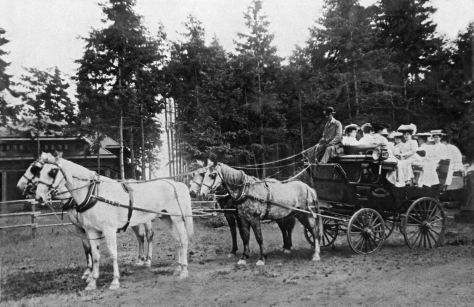(click to enlarge photos)



Here sits Joseph ”Daddy” Standley, one of the best-known self-promoters in Seattle history, relaxing in a real photo postcard beside his West Seattle home. The caption pasted to the print on the right names the home Totem Place. The name also appears on the column to the left of the stairs decorated with potted plants and two large shells.




Standley might be compared to three other local promotional players: Bill Speidel of the Underground Tours, Mark Mathews of First Presbyterian Church, and Ivar Haglund on Pier 54. All were accomplished storytellers and created most of their own publicity, largely by making themselves the news. “Daddy” Standley’s main stage, Ye Olde Curiosity Shop, was on the waterfront, where it remains in Ivar’s Pier 54 (soon to reopen, with a remodel and new seawall.)


The curio merchant’s life-long passion for collecting aboriginal artifacts is testimony to the importance of children’s literature. For having the “neatest desk” in his third grade class, young Joseph won a book about Indian life, lore, and crafts. The tome enchanted him so that ultimately the youthful anthropologist, to quote his namesake grandson, Joseph James, “turned his hobby into his business.”

In 1899, the 45-year-old curio collector arrived in Seattle from Colorado with his wife and four children. In Denver he had operated a grocery store, with as much shelf space given to collectibles as to fruits and vegetables. After a few moves and name changes, Standley’s curious collections found a home on Colman Dock. In 1906 the family built a home in West Seattle on Duwamish Head with a clear view across Elliott Bay to Colman Dock with their shop, steamers and ferries.

Shop’s first home on Madison Street, near Western Ave. (see below)

Joseph James has taken his grandfather’s place for Jean Sherrard’s repeat and also for the upkeep of Ye Old Curiosity Shop’s traditions, both commercial and cultural. Joe grew up in Totem Place and remembers fondly how the house became a second museum for Standley’s collections. Its wide lawn was a sanctuary for his second passion, gardening. A sculpture garden for about fifteen large totem poles and a “six-foot high mound built with shells from the seven seas” were an attraction for both the children of the neighborhood and sight-seeing busses.

Next Sunday, June 28, Totem Place again becomes an attraction when the Southwest Seattle Historical Society assembles there its experts, exhibits – including “totems on loan” – for “Ye Olde Home of Joseph “Daddy” Standley. It is this year’s offering for the Society’s annual event, “If These Walls Could Talk.” For details, call the Log House Museum at (206) 938-5293, or visit loghousemuseum.info.


WEB EXTRAS
Anything to add, boys (and that includes Clay Eals)? BY GOLLY YES Jean, but not so timely, except if my excuse for being behind time might be found also in our subject: history. No way that we can fill in this blog by 3AM this Sunday morning. I must write the next Pacific feature for the Times by then as well. The research notes are abundant – too abundant, but what a delight to gather them. So hopefully tomorrow I will return and add to this many neighborly features that can be manufactured with a little scanning of clips.
=====
Scanned clips to follow – sooner than later, we hope.
#











Check the date 1989 x 1889?